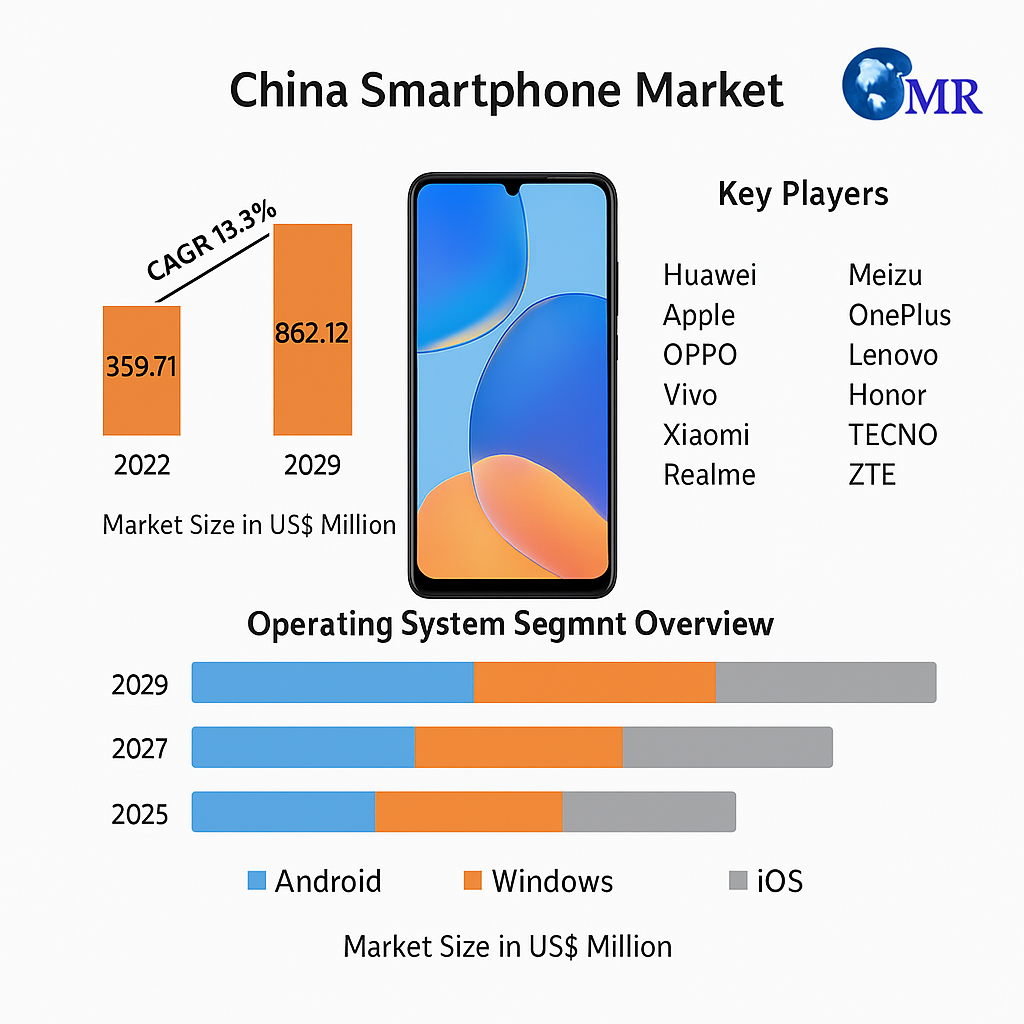The China smartphone market size is set to witness significant expansion, projected to grow from USD 359.71 million in 2022 to USD 862.12 million by 2029. This impressive trajectory represents a CAGR of 13.3%, highlighting China’s dominant role in global smartphone innovation, consumption, and manufacturing.
Market Estimation & Definition
The China smartphone market refers to the ecosystem comprising the production, distribution, sale, and technological advancement of smartphones within mainland China. With a starting valuation of USD 359.71 million in 2022, the market’s anticipated growth to over USD 860 million by 2029 demonstrates the increasing demand for mobile devices that deliver high performance at competitive prices.
The term “smartphone” includes mobile devices equipped with advanced computing capability and connectivity, offering users applications, multimedia, and high-speed internet access through 4G and 5G networks. China’s market comprises both domestic and international brands competing in various price segments, from budget to premium.
Market Growth Drivers & Opportunities
The upward momentum of China’s smartphone market is driven by several core growth factors and emerging opportunities:
5G Rollout
China remains a global leader in 5G infrastructure and connectivity. The nationwide push for high-speed internet has resulted in a massive shift in consumer preference towards 5G-compatible smartphones. The availability of affordable 5G devices is boosting replacement cycles and driving new sales.
Technological Advancements
Brands are consistently launching models with AI-enabled cameras, foldable displays, enhanced battery life, and improved performance chips. Innovations are no longer limited to premium segments, enabling mid-range and entry-level smartphones to capture a wider audience.
E-commerce & Livestreaming Sales
Digital retail channels, including major e-commerce platforms and livestreaming services, have revolutionized smartphone sales in China. Brands leverage influencer partnerships and real-time demos to convert audiences instantly, especially during national sales events.
Urbanization and Digitization
Rising digital penetration in Tier 2 and Tier 3 cities is creating untapped opportunities. More consumers are embracing smartphones for education, entertainment, remote work, and e-payments, making smartphones a necessity rather than a luxury.
Customization & Localization
Manufacturers are increasingly tailoring their offerings to fit regional language preferences, lifestyle needs, and app ecosystems, enhancing user engagement and satisfaction.
Segmentation Analysis
The market is segmented based on operating system and distribution channel:
By Operating System:
- Android: Dominates the market, particularly through domestic brands such as Xiaomi, Huawei, OPPO, and Vivo, which offer extensive customizations and app ecosystems.
- iOS: Maintains a strong position in the premium smartphone segment. The brand loyalty and integration with a wider Apple ecosystem attract affluent and tech-savvy consumers.
- Windows & Others: Occupy a negligible portion, with limited to no impact on current market dynamics.
By Distribution Channel:
- Online: The surge in online smartphone sales is being led by platforms like JD.com, Tmall, and Pinduoduo. These offer competitive pricing, flash sales, and convenient financing options.
- Offline: Physical retail remains relevant, especially in suburban and rural markets. Consumers often prefer to inspect devices in person before making purchasing decisions. Brick-and-mortar stores also play a key role in after-sales service and brand experience.
Country-Level Analysis
United States
Though the U.S. smartphone market is saturated, Chinese brands are gradually increasing visibility through online-only channels and tech-savvy consumer groups. However, geopolitical tensions and security concerns limit expansion opportunities. Strategic partnerships and innovation will be key to building trust and gaining traction.
Germany
Germany is a key market in the European Union, known for high standards in technology and privacy. Chinese brands have successfully entered the market by emphasizing value-for-money and forging relationships with local carriers. Demand for 5G and sustainable electronics is rising, offering opportunities for manufacturers that meet EU environmental regulations and consumer preferences.
Competitive Landscape
The China smartphone market is highly competitive, with domestic brands dominating due to their price-performance balance and rapid innovation cycles:
- Huawei: Continues to lead in innovation and domestic market share. Despite international restrictions, Huawei has maintained dominance through strong local support and diversification into HarmonyOS, its own operating system.
- Xiaomi: Known for its aggressive pricing and tech-centric community, Xiaomi appeals to cost-conscious consumers seeking flagship features in mid-range phones. Its Mi and Redmi series remain best-sellers.
- Apple: Strong in the premium market, Apple is perceived as a status symbol. Regular product launches, ecosystem integration, and financing programs ensure steady demand, especially in urban centers.
- Vivo and OPPO: Focus on camera and display innovations, appealing to the youth demographic. These brands have strong retail networks and are heavily invested in influencer-driven marketing.
- Realme and OnePlus: Target younger users with high-performance gaming and multitasking features. They are gaining ground in both online and offline channels.
These brands compete not only on features and pricing but also on customer experience, software integration, ecosystem development (e.g., wearables, IoT), and after-sales service.
The China smartphone market is positioned at the nexus of innovation, affordability, and scale. As the country continues to invest in 5G, AI, and digital infrastructure, the smartphone will remain central to economic and social transformation. The forecasted growth to USD 862.12 million by 2029 illustrates a market that is not just expanding, but evolving rapidly to meet changing user behaviors and technological landscapes.
To view Full Report:
https://www.maximizemarketresearch.com/market-report/china-smartphone-market/85746/
Manufacturers, investors, and service providers should align their strategies with the emerging trends: accelerated digital adoption, personalized device experiences, and omnichannel distribution. As competition intensifies, only those who innovate at speed, localize effectively, and deliver seamless customer journeys will thrive in China’s dynamic smartphone ecosystem.



